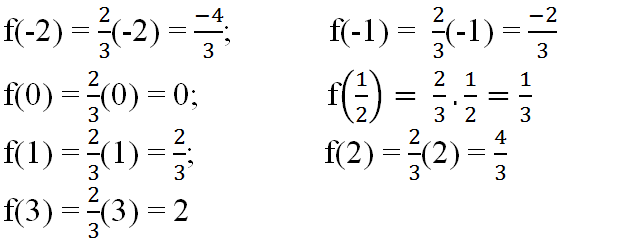Hãy nhập câu hỏi của bạn vào đây, nếu là tài khoản VIP, bạn sẽ được ưu tiên trả lời.

c: Ở hai hàm số trên, nếu lấy biến x cùng một giá trị thì f(x) sẽ nhỏ hơn g(x) 3 đơn vị

Câu 1:
a)
| \(y=f\left(x\right)=2x^2\) | -5 | -3 | 0 | 3 | 5 |
| f(x) | 50 | 18 | 0 | 18 | 50 |
b) Ta có: f(x)=8
\(\Leftrightarrow2x^2=8\)
\(\Leftrightarrow x^2=4\)
hay \(x\in\left\{2;-2\right\}\)
Vậy: Để f(x)=8 thì \(x\in\left\{2;-2\right\}\)
Ta có: \(f\left(x\right)=6-4\sqrt{2}\)
\(\Leftrightarrow2x^2=6-4\sqrt{2}\)
\(\Leftrightarrow x^2=3-2\sqrt{2}\)
\(\Leftrightarrow x=\sqrt{3-2\sqrt{2}}\)
hay \(x=\sqrt{2}-1\)
Vậy: Để \(f\left(x\right)=6-4\sqrt{2}\) thì \(x=\sqrt{2}-1\)

f(0) = 1/2.0 + 5 = 5
f(2) = 1/2.2 + 5 = 6
f(3) = 1/2.3 + 5 = 13/2
f(-2) = 1/2.(-2) + 5 = 4
f(-10) = 1/2.(-10) + 5 = 0

f(0) = 1/2.0 + 5 = 5
f(2) = 1/2.2 + 5 = 6
f(3) = 1/2.3 + 5 = 13/2
f(-2) = 1/2.(-2) + 5 = 4
f(-10) = 1/2.(-10) + 5 = 0

em xin lỗi nhưng em chưa đủ tuổi để làm bài này xin cáo từ
xin lỗi quản lý olm ạ
a) Ta có:
f(−2)=23.(−2)=−43;f(−1)=23.(−1)=−23;f(0)=23.0=0;f(12)=23.12=13;f(1)=23.1=23;f(2)=23.2=43;f(3)=23.3=2.f(−2)=23.(−2)=−43;f(−1)=23.(−1)=−23;f(0)=23.0=0;f(12)=23.12=13;f(1)=23.1=23;f(2)=23.2=43;f(3)=23.3=2.
b) Ta có:
g(−2)=23.(−2)+3=53;g(−1)=23.(−1)+3=73;g(0)=23.0+3=3;g(12)=23.12+3=103;g(1)=23.1+3=113;g(2)=23.2+3=133;g(3)=23.3+3=5.g(−2)=23.(−2)+3=53;g(−1)=23.(−1)+3=73;g(0)=23.0+3=3;g(12)=23.12+3=103;g(1)=23.1+3=113;g(2)=23.2+3=133;g(3)=23.3+3=5.
c) Khi biến xx lấy cùng một giá trị thì giá trị của hàm số y=f(x)y=f(x) luôn nhỏ hơn giá trị tương ứng của hàm số y=g(x)y=g(x) là 3 đơn vị.

c) Từ kết quả câu a, b ta được bảng sau:
Nhận xét:
- Các hàm số y = f(x) = 2/3 x và y = g(x) = 2/3 x + 3 là hai hàm số đồng biến vì khi x tăng thì y cũng nhận được các giá trị tương ứng tăng lên.
- Cùng một giá trị của biến x, giá trị của hàm số y = g(x) luôn luôn lớn hơn giá trị tương ứng của hàm số y = f(x) là 3 đơn vị.
a) Cho hàm số : \(y=f\left(x\right)=\dfrac{2}{3}x\)
Ta có : \(f\left(-2\right)=\dfrac{2}{3}.\left(-2\right)=-\dfrac{4}{3}\)
\(f\left(-1\right)=\dfrac{2}{3}.\left(-1\right)=-\dfrac{2}{3}\)
\(f\left(0\right)=\dfrac{2}{3}.0=0\)
\(f\left(\dfrac{1}{2}\right)=\dfrac{2}{3}.\dfrac{1}{2}=\dfrac{1}{3}\)
\(f\left(1\right)=\dfrac{2}{3}.1=\dfrac{2}{3}\)
\(f\left(2\right)=\dfrac{2}{3}.2=\dfrac{4}{3}\)
\(f\left(3\right)=\dfrac{2}{3}.3=2\)
b) Cho hàm số : \(y=g\left(x\right)=\dfrac{2}{3}x+3\)
\(g\left(-2\right)=\dfrac{2}{3}.\left(-2\right)+3=\dfrac{5}{3}\)
\(g\left(-1\right)=\dfrac{2}{3}.\left(-1\right)+3=\dfrac{7}{3}\)
\(g\left(0\right)=\dfrac{2}{3}.0+3=3\)
\(g\left(\dfrac{1}{2}\right)=\dfrac{2}{3}.\dfrac{1}{2}+3=\dfrac{10}{3}\)
\(g\left(1\right)=\dfrac{2}{3}.1+3=\dfrac{11}{3}\)
\(g\left(2\right)=\dfrac{2}{3}.2+3=\dfrac{13}{3}\)
\(g\left(3\right)=\dfrac{2}{3}.3+3=5\)
c) Khi \(x\)lấy cùng một giá trị thì giá trị của \(g\left(x\right)\) lớn hơn giá trị của \(f\left(x\right)\) là \(3\) đơn vị.


Giải:
Có \(y=f\left(x\right)=\dfrac{1}{2}x+5\)
\(\Leftrightarrow f\left(0\right)=\dfrac{1}{2}.0+5=0+5=5\)
\(\Leftrightarrow f\left(1\right)=\dfrac{1}{2}.1+5=\dfrac{1}{2}+5=\dfrac{11}{2}\)
\(\Leftrightarrow f\left(2\right)=\dfrac{1}{2}.2+5=1+5=6\)
\(\Leftrightarrow f\left(3\right)=\dfrac{1}{2}.3+5=\dfrac{3}{2}+5=\dfrac{13}{2}\)
\(\Leftrightarrow f\left(-2\right)=\dfrac{1}{2}.\left(-2\right)+5=-1+5=4\)
\(\Leftrightarrow f\left(-10\right)=\dfrac{1}{2}.\left(-10\right)+5=-5+5=0\)
Vậy ...
Chúc bạn học tốt!
\(y=f\left(x\right)=\dfrac{1}{2}x+5\)
Ta có : \(f\left(0\right)=\dfrac{1}{2}.0+5=5\)
\(f\left(1\right)=\dfrac{1}{2}.1+5=\dfrac{11}{2}=5,5\)
\(f\left(2\right)=\dfrac{1}{2}.2+5=6\)
\(f\left(3\right)=\dfrac{1}{2}.3+5=\dfrac{13}{2}=6,5\)
\(f\left(-2\right)=\dfrac{1}{2}.\left(-2\right)+5=4\)
\(f\left(-10\right)=\dfrac{1}{2}.\left(-10\right)+5=0\)
#HỌC TỐT ~~~